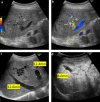Hereditary hemorrhagic telangiectasia with hepatic arteriovenous shunt diagnosed due to liver damage
- PMID: 38436842
- PMCID: PMC11127884
- DOI: 10.1007/s12328-024-01923-0
Hereditary hemorrhagic telangiectasia with hepatic arteriovenous shunt diagnosed due to liver damage
Abstract
A 53-year-old woman was diagnosed with liver dysfunction in August 20XX. Computed tomography (CT) revealed multiple hepatic AV shunts, and she was placed under observation. In March 20XX + 3, she developed back pain, and CT performed during an emergency hospital visit showed evidence of intrahepatic bile duct dilatation. She was referred to our gastroenterology department in May 20XX + 3. We conducted investigations on suspicion of hereditary hemorrhagic telangiectasia (HHT) with hepatic AV shunting based on contrast-enhanced CT performed at another hospital. HHT is generally discovered due to epistaxis, but there are also cases where it is diagnosed during examination of liver damage.
Keywords: Hepatic arteriovenous shunt; Hereditary hemorrhagic telangiectasia; Liver damage.
© 2024. The Author(s).
Conflict of interest statement
Masatoshi Kudo received patent royalties from Chugai Pharmaceutical Co., Ltd. Masatoshi Kudo received scholarship grants from Chugai Pharmaceutical Co., Ltd., TAIHO Pharmaceutical Co., Ltd., Otsuka Pharmaceutical Co., Ltd., GE Healthcare Japan Corporation and Eisai Co., Ltd.
Figures




Similar articles
-
Clinical diagnosis: Intrahepatic arteriovenous fistula associated with hereditary hemorrhagic telangiectasia.Ann Nucl Med. 2002 Nov;16(7):490, coverpage. doi: 10.1007/BF02988648. Ann Nucl Med. 2002. PMID: 12508841 No abstract available.
-
Definite hereditary hemorrhagic telangiectasia in a 60-year-old black Kenyan woman: a case report.J Med Case Rep. 2016 May 25;10(1):126. doi: 10.1186/s13256-016-0909-4. J Med Case Rep. 2016. PMID: 27225226 Free PMC article.
-
Hepatic arteriovenous malformations from hereditary hemorrhagic telangiectasia: treatment with liver transplantation.Dig Dis Sci. 2010 Nov;55(11):3059-62. doi: 10.1007/s10620-010-1353-8. Epub 2010 Sep 16. Dig Dis Sci. 2010. PMID: 20844961 No abstract available.
-
Medical management of haemorrhagic hereditary telangiectasia in adult patients.Med Clin (Barc). 2019 Apr 5;152(7):274-280. doi: 10.1016/j.medcli.2018.09.015. Epub 2018 Nov 27. Med Clin (Barc). 2019. PMID: 30502301 Review. English, Spanish.
-
Liver transplantation for cardiac failure in patients with hereditary hemorrhagic telangiectasia.Liver Transpl. 2005 Jul;11(7):834-838. doi: 10.1002/lt.20463. Liver Transpl. 2005. PMID: 15973723 Review.
Cited by
-
Hepatic Cyst Radioiodine Uptake on Whole-Body Scan in Differentiated Thyroid Cancer: Implications for Lesion Characterization and Misdiagnosis Avoidance.Cureus. 2025 Apr 22;17(4):e82789. doi: 10.7759/cureus.82789. eCollection 2025 Apr. Cureus. 2025. PMID: 40406782 Free PMC article.
References
-
- Osler W. On a family form of recurring epistaxis, associated with multiple telangiectases of the skin and mucous membranes. Bull Johns Hopkins Hosp. 1901;128:333–337.
-
- Hanes F. Multiple hereditary telangiectases causing hemorrhage (hereditary hemorrhagic telangiectasia) Bull Johns Hopkins Hosp. 1909;20:63–73.
Publication types
MeSH terms
LinkOut - more resources
Full Text Sources
Medical

